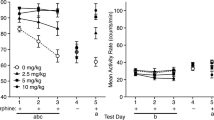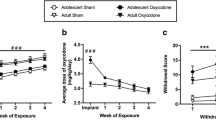Abstract
Rationale
Given the increasing abuse of prescription opioids, particularly in adolescents, surprisingly few preclinical studies have explored effects of opioids in adolescents (versus adults).
Objectives
This study compared the conditioned rewarding effects of morphine, without (experiment 1) and with morphine pre-exposure (experiment 2), in adolescent and adult male mice.
Methods
Experiment 1: On each of three consecutive days, one of the two conditioning sessions was preceded by an injection of a particular dose of morphine (0.1, 0.32, 1, 3.2, 10, 32, or 100 mg/kg, intraperitoneal) and the other by saline; place preference was tested on day 4. Experiment 2: Mice received once daily injections of saline or a particular dose of morphine (17.8 or 56 mg/kg) for 4 days, and 3 days later, place conditioning with morphine (0.32, 1, 3.2, or 10 mg/kg) began.
Results
In both experiments, morphine induced conditioned place preference along similar inverted U-shaped dose–response curves in adolescent and adult mice, with maximal effects between 0.32 and 10 mg/kg. Morphine pre-exposure did not sensitize morphine-induced conditioned place preference; instead, tolerance occurred, but only in adults. Adolescents were more sensitive than adults to morphine-induced locomotor stimulation. Response to novelty predicted the locomotor stimulating effects of morphine in adolescents, but not its rewarding effects.
Conclusions
The rewarding effects of morphine were similar in adolescent and adult mice but showed differential tolerance after morphine pre-exposure. Adolescents were more sensitive than adults to the acute locomotor stimulating effects of morphine, consistent with dopamine systems involved in locomotor activity being overactive during adolescence.




Similar content being viewed by others
References
Bolanos CA, Garmsen GM, Clair MA, McDougall SA (1996) Effects of the kappa-opioid receptor agonist U-50,488 on morphine-induced place preference in the developing rat. Eur J Pharmacol 317:1–8
Campbell JO, Wood RD, Spear LP (2000) Cocaine and morphine-induced conditioned place preference in adolescent and adult rats. Physiol Behav 68:487–493
Cohen J, Cohen P (1983) Applied multiple regression/correlation analysis for the behavioral sciences. Erlbaum, Hillsdale, p 54
Compton WM, Volkow ND (2006) Major increases in opioid analgesic abuse in the United States: concerns and strategies. Drug Alcohol Depend 81:103–107
Cunningham CL, Niehus DR, Malott DH, Prather LK (1992) Genetic differences in the rewarding and activating effects of morphine and ethanol. Psychopharmacology 107:385–393
Cunningham CL, Dickinson SD, Grahame NJ, Okorn DM, McMullin CS (1999) Genetic differences in cocaine-induced conditioned place preference in mice depend on conditioning trial duration. Psychopharmacology 146:73–80
Di Chiara G, Imperato A (1988) Opposite effects of mu and kappa opiate agonists on dopamine release in the nucleus accumbens and in the dorsal caudate of freely moving rats. J Pharmacol Exp Ther 244:10671080
Doherty JM, Frantz KJ (2012) Heroin self-administration and reinstatement of heroin-seeking in adolescent vs. adult male rats. Psychopharmacology 219:763–773
Doherty JM, Frantz KJ (2013) Attenuated effects of experimenter-administered heroin in adolescent vs. adult male rats: physical withdrawal and locomotor sensitization. Psychopharmacology 225:595–604
Doherty J, Ogbomnwan Y, Williams B, Frantz K (2009) Age-dependent morphine intake and cue-induced reinstatement, but not escalation in intake, by adolescent and adult male rats. Pharmacol Biochem Behav 92:164–172
Hnasko TS, Sotak BN, Palmiter RD (2005) Morphine reward in dopamine-deficient mice. Nature 438:854–857
Hodgson SR, Hofford RS, Wellman PJ, Eitan S (2009) Different affective response to opioid withdrawal in adolescent and adult mice. Life Sci 84:52–60
Ingram SL, Fossum EN, Morgan MM (2007) Behavioral and electrophysiological evidence for opioid tolerance in adolescent rats. Neuropsychopharmacology 32:600–606
Ishikawa K, Shibanoki S, McGaugh JL (1983) Direct correlation between level of morphine and its biochemical effect on monoamine systems in mouse brain. Biochem Pharmacol 32:1473–1478
Johnson SW, North RA (1992) Opioids excite dopamine neurons by hyperpolarization of local interneurons. J Neurosci 12:483–488
Joyce EM, Iversen SD (1979) The effect of morphine applied locally to mesencephalic dopamine cell bodies on spontaneous motor activity in the rat. Neurosci Lett 14:207–212
Kalivas PW, Duffy P (1987) Sensitization to repeated morphine injection in the rat: possible involvement of A10 dopamine neurons. J Pharmacol Exp Ther 241:204–212
Koek W (2014) Effects of repeated exposure to morphine in adolescent and adult male C57BL/6J mice: agedependent differences in locomotor stimulation, sensitization, and body weight loss. Psychopharmacology 231:1517–1529
Koek W, France CP, Javors MA (2012) Morphine-induced motor stimulation, motor incoordination, and hypothermia in adolescent and adult mice. Psychopharmacology 219:1027–1037
Kuribara H (1996) Effects of interdose interval on ambulatory sensitization to methamphetamine, cocaine and morphine in mice. Eur J Pharmacol 316:1–5
Luo J, Jing L, Qin W-J, Zhang M, Lawrence AJ, Chen F, Liang J-H (2011) Transcription and protein synthesis inhibitors reduce the induction of behavioural sensitization to a single morphine exposure and regulate Hsp70 expression in the mouse nucleus accumbens. Int J Neuropsychopharmacol 14:107–121
McCutcheon JE, Conrad KL, Carr SB, Ford KA, McGehee DS, Marinelli M (2012) Dopamine neurons in the ventral tegmental area fire faster in adolescent rats than in adults. J Neurophysiol 108:1620–1630
Narendran R, Martinez D (2008) Cocaine abuse and sensitization of striatal dopamine transmission: a critical review of the preclinical and clinical imaging literature. Synapse 62:851–869
Niikura K, Ho A, Kreek MJ, Zhang Y (2013) Oxycodone-induced conditioned place preference and sensitization of locomotor activity in adolescent and adult mice. Pharmacol Biochem Behav 110:112–116
Pelloux Y, Costentin J, Duterte-Boucher D (2006) Novelty preference predicts place conditioning to morphine and its oral consumption in rats. Pharmacol Biochem Behav 84:43–50
Phillips AG, LePiane FG (1980) Reinforcing effects of morphine microinjection into the ventral tegmental area. Pharmacol Biochem Behav 12:965–968
Piazza PV, Deminiere JM, Maccari S, Mormede P, Le Moal M, Simon H (1990) Individual reactivity to novelty predicts probability of amphetamine self-administration. Behav Pharmacol 1:339–345
Quertemont E, Brabant C, Tirelli E (2004) Response to novelty as a predictor for drug effects: the pitfalls of some correlational studies. Psychopharmacology 173:221–224
Robinson TE, Berridge KC (2003) Addic Annu Rev Psychol 54:25–53
Robinson TE, Berridge KC (2008) The incentive sensitization theory of addiction: some current issues. Philos Trans R Soc Lond B Biol Sci 363:3137–3146
Schramm-Sapyta NL, Walker QD, Caster JM, Levin ED, Kuhn CM (2009) Are adolescents more vulnerable to drug addiction than adults? Evidence from animal models. Psychopharmacology (Berl) 206:1–21
Shippenberg TS, Herz A (1987) Place preference conditioning reveals the involvement of D1-dopamine receptors in the motivational properties of mu- and kappa-opioid agonists. Brain Res 436:169–172
Shippenberg TS, Heidbreder C, LeFevour A (1996) Sensitization to the conditioned rewarding effects of morphine: pharmacology and temporal characteristics. Eur J Pharmacol 299:33–39
Shippenberg TS, LeFevour A, Thompson AC (1998) Sensitization to the conditioned rewarding effects of morphine and cocaine: differential effects of the kappa-opioid receptor agonist U69593. Eur J Pharmacol 345:27–34
Spear LP (2000) The adolescent brain and age-related behavioral manifestations. Neurosci Biobehav Rev 24:417–463
Spear LP, Horowitz GP, Lipovsky J (1982) Altered behavioral responsivity to morphine during the periadolescent period in rats. Behav Brain Res 4:279–288
Substance Abuse and Mental Health Services Administration (2003) Overview of findings from the 2002 National Survey on Drug Use and Health. Substance Abuse and Mental Health Services Administration. Office of Applied Studies, Rockville
Talbot JN, Happe HK, Murrin LC (2005) Mu opioid receptor coupling to Gi/o proteins increases during postnatal development in rat brain. J Pharmacol Exp Ther 314:596–602
Tzschentke TM (1998) Measuring reward with the conditioned place preference paradigm: a comprehensive review of drug effetcs, recent progress and new issues. Prog Neurobiol 56:613–672
Tzschentke TM (2004) Reassessment of buprenorphine in conditioned place preference: temporal and pharmacological considerations. Psychopharmacology 172:58–67
Tzschentke TM (2007) Measuring reward with the conditioned place preference (CPP) paradigm: update of the last decade. Addict Biol 12:227–462
Valjent E, Bertran-Gonzalez J, Aubier B, Greengard P, Herve D, Girault J-A (2010) Mechanisms of locomotor sensitization to drugs of abuse in a two-injection protocol. Neuropsychopharmacology 35:401–415
Vanderschuren LJ, Pierce RC (2010) Sensitization processes in drug addiction. Curr Top Behav Neurosci 3:179–195
Vanderschuren LJ, Tjon GH, Nestby P, Mulder AH, Schoffelmeer AN, De Vries TJ (1997) Morphine-induced long-term sensitization to the locomotor effects of morphine and amphetamine depends on the temporal pattern of the pretreatment regimen. Psychopharmacology 131:115–122
Vanderschuren LJ, De Vries TJ, Wardeh G, Hogenboom FA, Schoffelmeer AN (2001) A single exposure to morphine induces long-lasting behavioural and neurochemical sensitization in rats. Eur J Neurosci 14:1533–1538
Vezina P, Stewart J (1987) Morphine conditioned place preference and locomotion: the effect of confinement during training. Psychopharmacology 93:257–260
Wahlstrom D, White T, Luciana M (2010) Neurobehavioral evidence for changes in dopamine system activity during adolescence. Neurosci Biobehav Rev 34:631–648
White DA, Holtzman SG (2005) Periadolescent morphine exposure alters subsequent behavioral sensitivity to morphine in adult rats. Eur J Pharmacol 528:119–123
White DA, Michaels CC, Holtzman SG (2008) Periadolescent male but not female rats have higher motor activity in response to morphine than do adult rats. Pharmacol Biochem Behav 89:188–199
Zhang Y, Picetti R, Butelman ER, Schlussman SD, Ho A, Kreek MJ (2009) Behavioral and neurochemical changes induced by oxycodone differ between adolescent and adult mice. Neuropsychopharmacology 34:912–922
Acknowledgments
The author thanks Jason Persyn, Chris Limas, Bindumahi Sudaabattula, and Sonia Cano for technical assistance. The work was supported by the US Public Health Service Grant DA23261.
Author information
Authors and Affiliations
Corresponding author
Rights and permissions
About this article
Cite this article
Koek, W. Morphine-induced conditioned place preference and effects of morphine pre-exposure in adolescent and adult male C57BL/6J mice. Psychopharmacology 233, 2015–2024 (2016). https://doi.org/10.1007/s00213-014-3695-y
Received:
Accepted:
Published:
Issue Date:
DOI: https://doi.org/10.1007/s00213-014-3695-y




